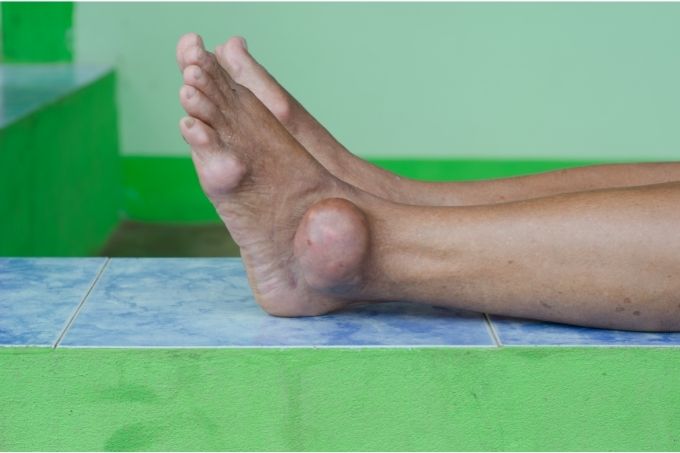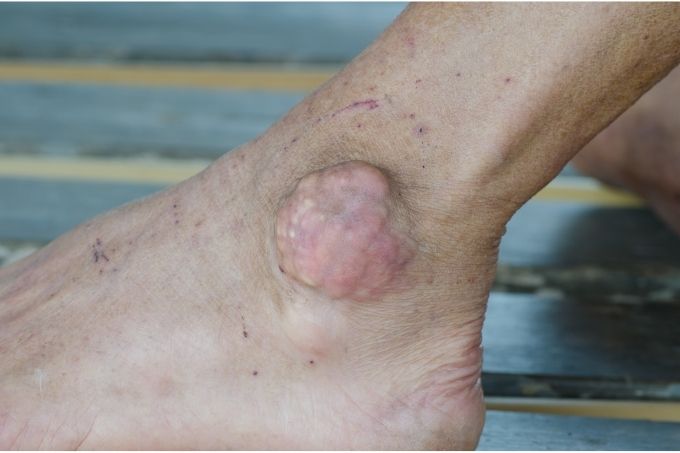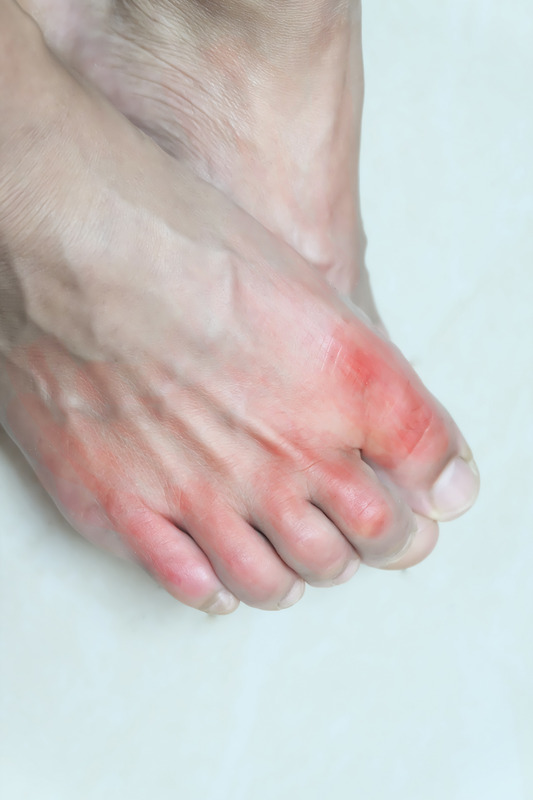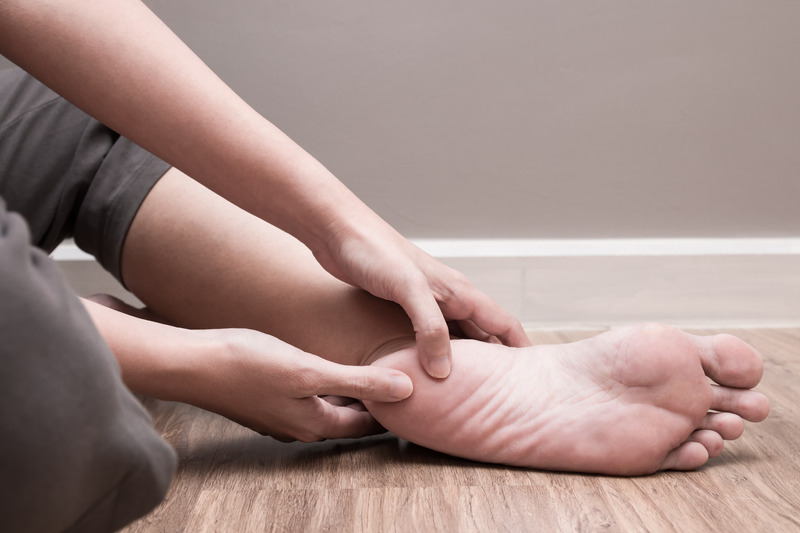
Have you encountered mobility problems due to pain and swelling in your big toe and feet? You think of using crutches to move around. The symptom indicates gout in the joints of your big toe. However, we are going to talk about gout in the ankle.
Can you get gout in your ankle?
You might have already noticed gout symptoms in your big toe. Within a few days, you would also find them in your ankle. Gout is a type of arthritis, and the cause of the pain is the accumulation of uric acid.
While you eat some foods and drinks like corn syrup, alcohol, and red meat, your body produces uric acid during digestion. Your kidneys play an important role in filtering out the uric acid and discharging it in urine.
However, for gout patients, the uric acid slowly gets accumulated in your body. Ultimately, it creates some needle-like crystals, which build up in the joints. In most cases, your big toe and ankle have these crystals of uric acid.
Symptoms
There is a chance of misdiagnosing ankle gout as other ailments like cellulitis and sprained ankle. But, physicians try to look for other symptoms to confirm that you have gout in your ankle.
- Pain – The sprained ankle becomes tender due to gout, and you will feel pain. Several patients with ankle gout have found it difficult to walk around.
- Stiffness – Stiffness is one of the common symptoms of patients with gout. Your ankle joint will become stiff, and you will feel a dull ache on that part.
- Color – Redness of the joint indicates that you have gout on your ankle.
- Swelling – Intense swelling is another symptom of ankle gout.
- Texture – The affected part of the skin will become shiny.
- Temperature – The ankle joint affected with gout will be much warmer.
Gout is highly painful and unbearable. However, there are treatments to alleviate the symptoms of further attacks. Women after menopause and men over 30 have a higher chance of gout in the ankles and other parts. Symptoms can develop within a few hours and last for 3 to 10 days. You will then find the joint in normal condition. But, you may again notice gout within a year. To prevent the reappearance of gout symptoms in your ankle, you have to rely on proper treatments.
Suggested article: The ULTIMATE Guide to Know Everything about Gout Symptoms
Causes
Your ankle comprises a set of tendons, bones, cartilage, and ligaments. It bears your weight while you are running, walking, and standing. Injuries and other conditions may affect your ankles. Ultimately, you feel the pain at the time of walking.
In fact, injury during physical activities is the most common cause of ankle pain. However, several other conditions may also result in ankle pain.
Of course, injury is not the only cause of gout. There are some other factors triggering the symptoms of gout. Women have a chance of suffering from this condition at an older age.
Therapists and other specialists are not sure why some patients have problems in processing the uric acid. In some cases, it is a genetic condition. Other potential factors developing the condition like gout are-
- Consumption of high-purine foods regularly
- Consumption of alcohol that increases the production of uric acid
- Overweight
Heart failure and higher blood pressure also promote and intensify the symptoms of gout. As you take diuretics to cure these disorders, they can increase your gout risks.

Diagnosis
We have already told you about the symptoms, which make it easy for you to identify gout in your ankle. However, your physician will ask you to do some tests to ensure proper diagnosis and effective treatment of the symptom.
- Blood test- Another reliable way to measure the uric acid level in your blood is a blood test. However, in some cases, results from a blood test may be misleading. Some patients with high uric acid do not have gout. On the contrary, patients with gout symptoms have normal levels of uric acid.
- Joint fluid test- For this test,your healthcare provider will use a needle to take a little amount of fluid from the concerned joint. Uric acid crystals will be visible while the fluid is tested using a microscope.
- Ultrasound- It is an advanced way of using sound waves for the detection of urate crystals in tophi and joints.
- X-ray imaging- X-rays of the joints are useful for knowing other potential causes of inflammation.
- Dual-energy computerized tomography- It is another test combining X-ray images from multiple angles to identify urate crystals in your ankle joints.
These are some options for an accurate diagnosis of the condition.
Treatment
You can take medications to get a faster remedy for ankle gout. Two types of gout medications focus on two problems. Physicians will prescribe different medications for
- Inflammation
- The resulting pain
Medications for pain will help you in preventing gout complications by reducing the uric acid level of your blood. The physician will decide on the type of medications based on the severity and frequency of your gout symptoms. He also focuses on your underlying health issues.
Common medications useful for treating gout flares are-
- Nonsteroidal anti-inflammatory medications- They include some over-the-counter drugs, including ibuprofen, naproxen sodium, and indomethacin. These drugs may result in ulcers, stomach pain, and bleeding.
- Colchicine– Colchicine is another anti-inflammatory drug capable of reducing gout pain effectively. However, the effectiveness of the drug may vary due to side effects like diarrhea, vomiting, and nausea.
- Corticosteroids- Prednisone and other corticosteroid drugs control gout pain and inflammation. Corticosteroids are available as pills, which are easy to consume. You may also inject corticosteroids into your joint. However, corticosteroids have side effects like high blood pressure and blood sugar.
Some patients have gout attacks every year. Others have complained that gout attacks are not frequent though painful. There are medications to reduce the uric acid level.
For instance, you can take allopurinol and other similar drugs to block the production of uric acid. However, allopurinol has side effects like rash, fever, kidney problems, and hepatitis. For better removal of uric acid, you can take drugs like probenecid.
Natural remedies of ankle gout
- Drink more water– As gout causes inflammation and swelling in joints, you need to drink much amount of water. By drinking water, you can reduce the swelling condition. Intake of more fluid will encourage your kidneys to discharge fluids. That is why you can alleviate swelling at your joints. (more here)
- Add ginger to your diet– Ginger has anti-inflammatory properties, and thus, you may use it for gout treatment. To make this home treatment effective, you have to boil water and add one tablespoon of grated ginger. Then, apply ginger to the affected part. You must do it at least once every day for about 15 to 30 minutes. You may also drink the solution of water and ginger daily. (more here)
- Cherries– Researchers have noticed that the consumption of cherries can minimize the gout risk. Cherries have anthocyanins that fight against inflammation. So drink cherry juice regularly to reduce your gout symptoms. (more here)
- Apply ice– Cover an ice pack in a cloth and apply it to your affected part. This trick will help you in reducing inflammation. Leave the ice pack for 10 to 20 minutes. (more here)
- Apple cider vinegar– It is another solution for your pain and swelling issues caused by gout. Add a spoon of vinegar to warm water. You will slowly get relief in this condition. (more here)
In conclusion, we can say that gout in the ankle is curable with proper treatment. You can consult a rheumatologist to take the right medications. Moreover, you can combine these medications with home remedies. Do not eat foods and drinks that increase your uric acid level.
Suggested articles:
– Gout in Neck – Can you Get Gout in Your Neck?
– Gout in Elbow – Can You Get Gout In Your Elbow?
– What Is Gout? – Symptoms, Stages and Treatment Of Gout
– Gout Tophi – Treating Or Living With Tophi
– Gout in Hands – Symptoms, Causes, Treatment
– Walking with Gout – Should I Walk with Gout?
– Gout in Heel – What Are the Symptoms and Treatments?
The Gout Eraser™: The all-natural guide for permanent gout removal
The Gout Eraser™ is a short, to the point guide on how to reverse gout symptoms without ever leaving your home. The guide goes into extensive detail on exactly what you need to do to safely, effectively and permanently get rid of gout, and you are GUARANTEED to see dramatic improvements in days if not hours.
To learn more about The Gout Eraser™ system, check out the following free video presentation: The Gout Eraser™





